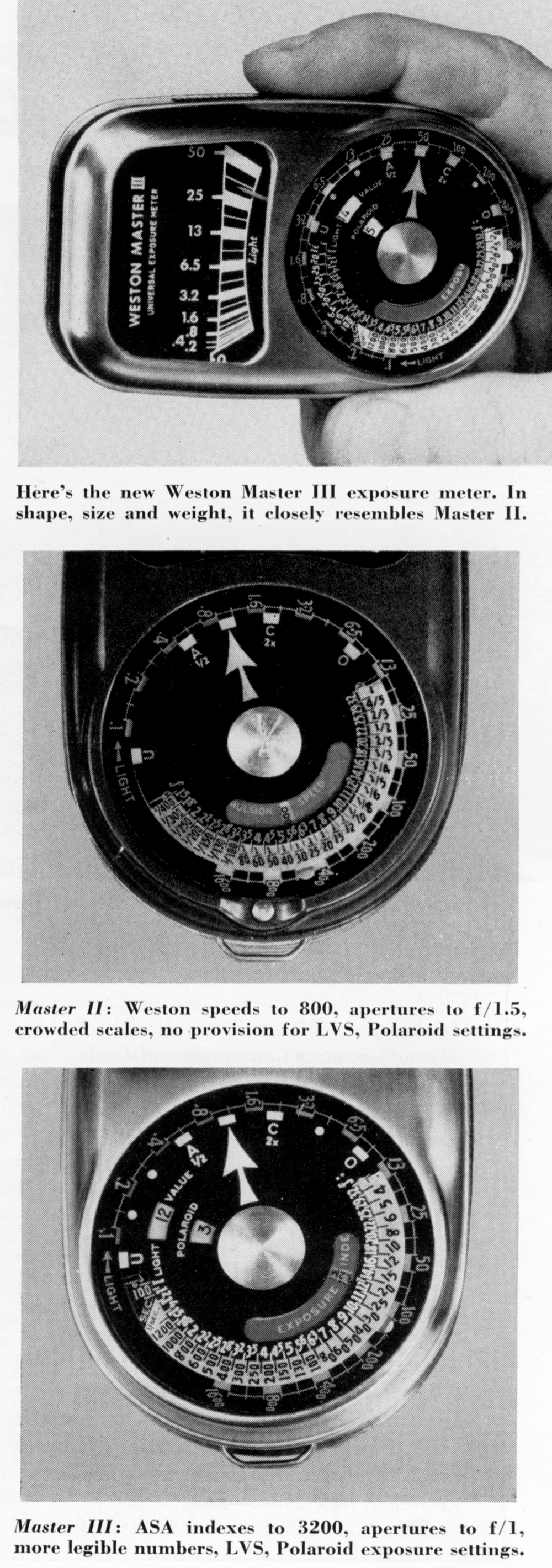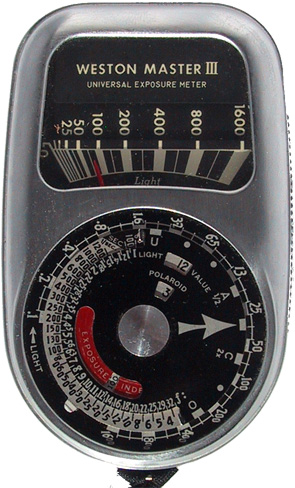|
-sm.jpg) Weston meters were made by Weston Electrical Instrument, started the late 1800s by Edward Weston (not to be confused with Edward Weston, the famous photographer). They pioneered photo-electric meters; their Model 617 was the first to be commercially available for photograpers; their system of rating film speeds, Weston Numbers, was very popular in the US. They were highly regarded by the pros (Ansel Adams used Weston Masters), and they did very well until the 1960s when on-board camera meters killed most of the market for hand-held meters. Weston meters were made by Weston Electrical Instrument, started the late 1800s by Edward Weston (not to be confused with Edward Weston, the famous photographer). They pioneered photo-electric meters; their Model 617 was the first to be commercially available for photograpers; their system of rating film speeds, Weston Numbers, was very popular in the US. They were highly regarded by the pros (Ansel Adams used Weston Masters), and they did very well until the 1960s when on-board camera meters killed most of the market for hand-held meters.
Despite the fact that most of the older ones are sick or dead by now (older ones really ought to be checked and calibrated before you rely on them), they have a lot of character and they're famous, which gives them a collectable value out of tune with their functional worth. Especially the old Master series, which were used by many famous photographers in their day.
This Master III came out in 1956, and is the first of the Masters to have the exposure index scale calibrated in ASA, not Weston, so it could still be used today without having to adjust for it (Weston EI numbers are about 1/3rd stop slower than ASA).
This is one of my selenium-era meters that I wish still worked (another being my Norton Director). It's a beauty that the photo here just doesn't describe. Unlike most meters of that time it appears to have a metal case; the chrome top is polished. It's dense and fairly heavy, but it's nicely balanced and feels great in my hand. The fit and finish remind me of a Rolleiflex or a good watch, and the whole thing looks like it was made by men who cared about their work, rather than manufactured in mass by people who watched the clock for break time. I can see why people like Ansel Adams loved these things.
This is the last of the American-made Westons. They were purchased by Daystrom, and after that the Masters were made at the Sangamo-Weston plant in England.
The following article appeared in the June, 1956 edition of Modern Photography, pp. 73, 122 and 124. It was written by Herb Keppler.
 The Weston Electrical Instrument Company does not change designs in its exposure meters capriciously. In twenty years there have been only two Weston Master meter models: the pre-war Master I, the smaller, postwar Master II. Now comes the Master III. The Weston Electrical Instrument Company does not change designs in its exposure meters capriciously. In twenty years there have been only two Weston Master meter models: the pre-war Master I, the smaller, postwar Master II. Now comes the Master III.
At first glance there seems little difference between the II and III aside from a brightly polished metal case which replaces the gray and black housing of the II. But there's a great deal more. Inwardly the III meter movement, which has the same sensitivity as the II, is cushion-mounted within the case: the jewel bearings ride on tiny springs and, while exposure meters do not take kindly to 30-foot drops on cement floors, the Master III should take a few more jars than the II without damage or misalignment.
Outwardly, most of the changes can be seen on the exposure control dial. The small window in which the film speed is indicated no longer reads "emulsion speeds." It now says "exposure index" indicating that the Weston Master III is calibrated to ASA specifications rather than the traditional Weston film ratings. (We'll get back to the importance of this later.) Aperture scales which read in 1/s stops now start at f/1 rather than f/1.5. Exposure indexes reading to 3200 should take care of any faster films yet to come—at least for a while. There are two cutout windows on the movable part of the dial in which appear light value numbers for cameras equipped with LVS scales and also Polaroid-exposure numbers for the Polaroid Land cameras.
There are other changes on the computing dial. The whole dial has been increased 1/10 in. in diameter allowing larger and thus more legible aperture and shutter speed numbers. To make the shutter speed numbers even larger and more readable they have been further simplified. There are no more fractions. You can't mistake 100 (actually 1/100) for 100 seconds however. All full second and longer exposures are white on black while fractions are inscribed black on white.
Lastly, you'll notice white dots spaced between the U. 0. A, and C markings. These with the U, 0, A, and C settings indicate full stop differences in aperture. If you want to change exposure by one full stop, these dots should make it easier to do so without resorting to memorizing the full stops or doing mathematics on the spot.
Now let's get back to the important news. No more Weston speeds? ASA only:1 Weston announced that both systems of ratings would be published for owners of old and new meters. Their first published folder with both ASA and Weston speeds gives the following information:
"WESTON SYSTEM—Films for test are purchased across the counter at photographic stores throughout the United States. Exposures are made in a Standardized Sensitometer and development is done strictly in accordance with the recommendations of each film manufacturer with respect to developer and time. The film rating is then determined from the resulting characteristic curve. "EXPOSURE INDEX—Films for test are purchased across the counter at photographic stores throughout the United States. Exposures are made in a Standardized Sensitometer and the films are then developed to the American Standards Association's specifications.
"The interpretation of the characteristic curve of each film follows exactly the ASA specification, 'American Standard Method for Determining Photographic Speed and Exposure Index.' The film rating is then determined from the resulting characteristic curve. "NOTE—Color, black-and-white reversal-process movie films and Polaroid material cannot be tested by the Weston or ASA methods. Film ratings for these are determined by exposing film in carefully calibrated cameras and developing the film in accordance with the film manufacturer's recommendations."
The listings of speeds in the folder indicate that there is little practical difference between Weston and ASA indexes. Sometimes the Weston number is slightly higher than the ASA number, sometimes it's the other way around. The maximum variation between any of them would only amount to half a stop or so, a difference which would hardly show up in a standard black-and-white negative. So for all practical purposes, in general black-and-white photography the numbers are interchangeable. In color, however, the ASA exposure indexes seem about 20 per cent higher than the Weston. And it's advisable to set them accordingly.
So Weston will continue to operate its own sensitometric labs as always, checking facts instead of relying on film manufacturer's claims, assuring the photographer of an unbiased account of each new film as well as constant re-checks on old ones. Those small Weston folders listing film speeds represent an extremely important but unsung Weston service for all exposure meter owners. Over twenty-five years ago. Weston labs established order out of the chaos of film manufacturers' claims and established the Weston system, the first workable system of classifying film speeds in the US. It's good to know that Weston's labs will now continue to serve with ASA exposure indexes and Weston film ratings.
Oh yes. the price of the Weston III meter is $32.50 including a carrying case.—h.k.
|




-sm.jpg)
